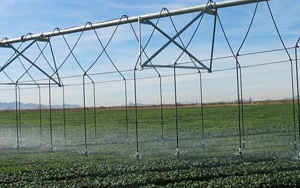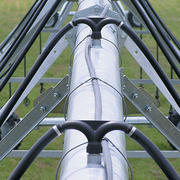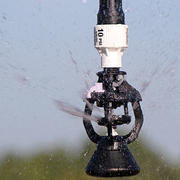
Understanding soil texture is critical for successful crop production. It is crucial to determine what crops grow best in a field and how farmers should manage their land, including the best irrigation method.
Soil and water compatibility is essential to irrigated land. Water that is not applied at a rate and intensity compatible with a farm's soil texture will have adverse effects on the chemical and physical properties of the soil. That is why focusing on soil is vital to irrigation management and selecting the right equipment for the job. While there are various considerations when selecting a sprinkler system, there are three reasons to prioritize soil texture: understanding infiltration rates, focusing on application rate, and considering application intensity.
1. Understanding Infiltration Rates
A good understanding of a field's soil texture will help irrigators determine the length and frequency of irrigation events. Water infiltrates soil's pores at varying rates depending on texture. For example, water infiltrates through dense, clay soils around 1 to 5 mm/hr, while sandy soils can absorb water at 30 mm/hr. This means that a water layer of 30mm on the soil surface will take one hour to infiltrate sandy soil.
However, this amount of water will take much longer to infiltrate clay soils. With more than 5mm/hr, runoff, soil sealing, and salinity issues are likely due to poor drainage and pooling on the soil surface. As a rule of thumb, farmers irrigating sandy soils need to irrigate more often for shorter intervals. Irrigating sandy soil for too long will waste water due to deep percolations and wash nutrients beneath the root zone. Clay soils require long and infrequent irrigation, while loam soils are somewhere in between.
2. Focus on Application Rate
The application rate of a sprinkler system must match the intake rate of the least porous soil in a field. If the application exceeds the soil intake rate, water will run off or relocate within the field, resulting in over and under-watered areas.
Matching sprinkler application rates to the soil intake rate can be difficult. The rate at which water infiltrates into the soil is complex. First, the intake rate varies with time, being higher when water is first applied and decreasing as the soil obtains more moisture. The application rate also varies depending on the crop growing.
For example, corn may need 7.0 mm (0.27 inches) of water per day during ear formation, no matter the soil type. Growers irrigating sandy soils will probably need to apply 1499 L/hr (6.6 GPM) for every acre irrigated to keep the crop healthy. In contrast, growers irrigating silt-loam soil may only need to use 1113 L/hr (4.9 GPM) for every acre.
If the corn is rotated with dry beans later on though, then growers will need sprinklers that can be adjusted to apply 1612 L/hr (7.1 GPM) for every acre irrigated over sandy soils. Irrigating just taking into account crop needs alone is risky and could result in lesser yields or poor crop development.
3. Don’t Forget Application Intensity
Before choosing a sprinkler system based on flow rate alone, it is important to consider the sprinkler's wetted pattern and how the water is applied over the soil surface. As water droplets are distributed onto the soil, the structure and infiltration rate of the soil become altered. To keep soil close to its pre-irrigation state, growers must distribute water over the largest area of instantaneous coverage possible and with low application intensity.
Although larger droplets are desirable to combat wind drift, too-large droplets have higher kinetic energy. This can cause surface sealing, erosion, or inefficient irrigation on tighter soils. Tighter soils generally benefit from smaller droplets, while looser soils can accept larger droplets.
Sprinklers with customizable deflectors and a wide range of nozzles, like the Senninger® i-Wob®2, are well suited for various soil textures due to the variety of droplet sizes available. The droplet size can be tailored to the soil's needs, and the flow rate can be adjusted for specific crop and climatic needs.
Understanding soil texture and its interaction with water is crucial for effective irrigation management. By focusing on the soil when selecting a sprinkler system, farmers can ensure optimal water use, maintain soil health, and ultimately achieve better crop yields.



